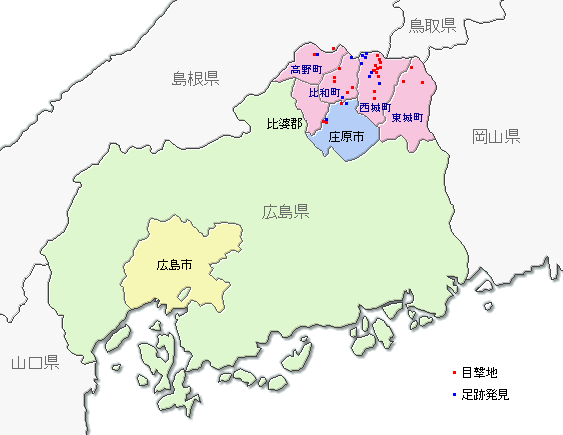 the 1974 hibagon photo (colourized) |  An alleged hibagon track |  A map of hibagon sightings around Mt. Hiba |
|---|
Hibagon
The Hibagon is an unknown primate said to live in the Chūgoku region of Honshu, primarily near the Hiba-Dogo-Taishaku National Park in the Hiroshima Prefecture. The park is more than 75,000 square kilometres of protected subtropical evergreen forest, home to numerous Asiatic black bears, Japanese macaques, and the elusive Japanese Giant Salamander.
Hibagons are described as being five to six-foot-tall gorilla-like animals with long arms, black or dark brown fur, and leathery skin. They are said to have a large head, a snub nose, and bristly hairs around its face. They have square-shaped footprints, being almost as wide as they are long. Their feet are somewhat like that of a macaque, albeit much larger.
Unlike most unknown primates, hibagons are often claimed to have first been reported in the modern era, with sightings starting in the 1970s. Various reports that could be referring to hibagons prior to the 20th century are known, such as a mention of two "baboons" being caught in what is now the Niigata and Shizuoka prefectures in the 1712 book Wakan Sansai Zue, or “Illustrated Sino-Japanese Encyclopedia.” Also, in the late 18th century, a man-sized ape with a large mouth and shining eyes were reported around Mt. Bandai in what is now the Fukushima Prefecture.
The first modern sighting attributed to a hibagon was in May of 1970, when a group of elementary school students on a field trip were picking mushrooms at Hiba-Dogo-Taishaku National Park. The creature puffed up its chest and started charging at the children, while snapping and twisting branches. Instead of attacking, however, it leaped away. The group of students ran to the teacher and explained their encounter, but when they went back, nothing was there except for trampled vegetation and a foul smell.
On July 20th, 1970, Yokio Sazawa claimed to have encountered a hibagon in the hills around Mount Hiba. He saw the gorilla-like animal digging in the ground, possibly foraging for sweet potatoes. Sazawa guessed it was around 200 pounds and five feet in height and said it had a snub-nose and "large, deep, glaring eyes."
In December of 1970, a trackway of 21 centimetre (eight-inch) footprints were found in the snow near Mt. Hiba. The tracks (above) were similar to that of Japanese macaques who are known to live in the area but these prints were wider and significantly larger.
In August of 1974, a motorist claimed to have seen a hibagon walk across the road. When the witness drove closer to the animal, it noticed him, and stood up on its hind legs and walked into the forest. Luckily, the witness managed to take a photo of the animal as it was walking away. Though the photo is blurry, it shows the creature standing next to a persimmon tree with one arm on a branch and its back to the photographer.
Unknown apes of presumably the same species have occurred elsewhere in Japan. For instance, on October 20th, 1980, a six-foot-tall, greyish-brown ape was seen bounding through the forest and across a river in Yamanocho, about two hours southeast of Mt. Hiba. In 1982, a hibagon-like animal, though slightly larger at around 6.5 feet, was seen carrying a handaxe in the forest near Mitsugi.
In April of 2006, Minako Hako and his son took photos of unusual tracks in the snow near the small town of Ikaho Onsen in the Gunma Prefecture in southern Honshu. Although the tracks were released to the public on April Fools day, Hako is adamant that it was not a practical joke and still stands by the authenticity of the photos. Also near Ikaho Onsen a couple of years before, an anonymous person claimed to have encountered a hairy ape-like creature they called a kemonohito or “beast man.” The person screamed, which made the creature look back at them, and then walked away into the forest.

